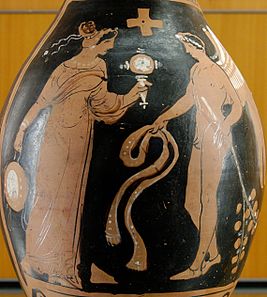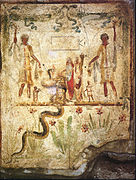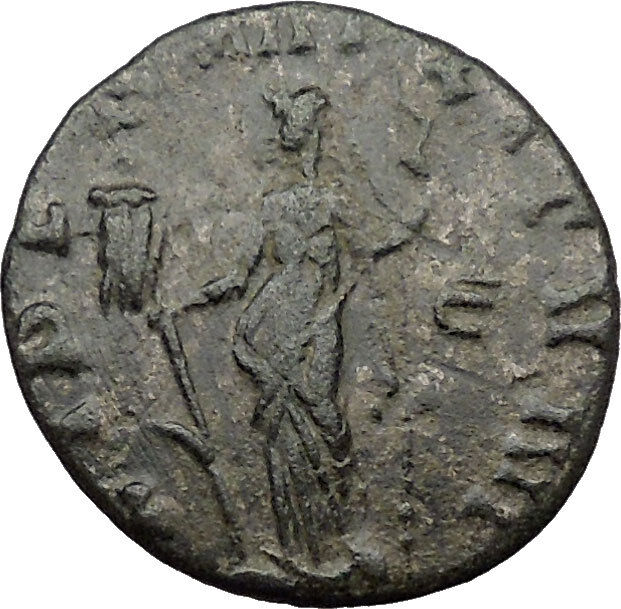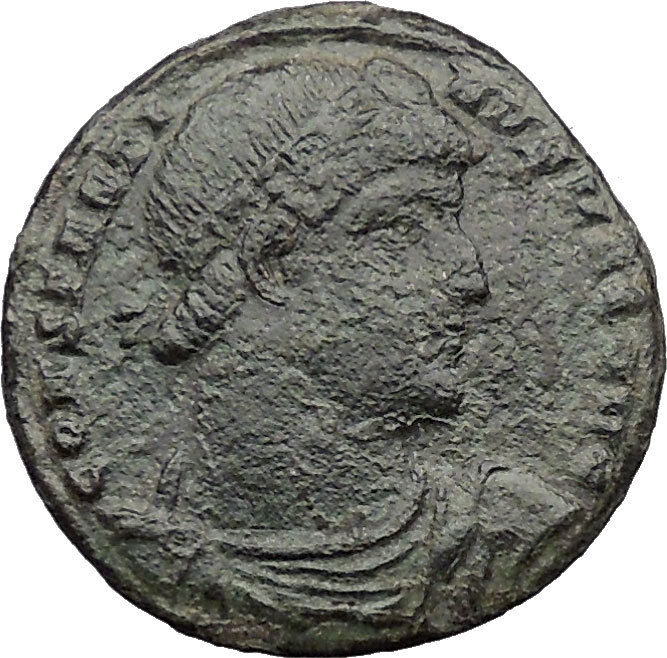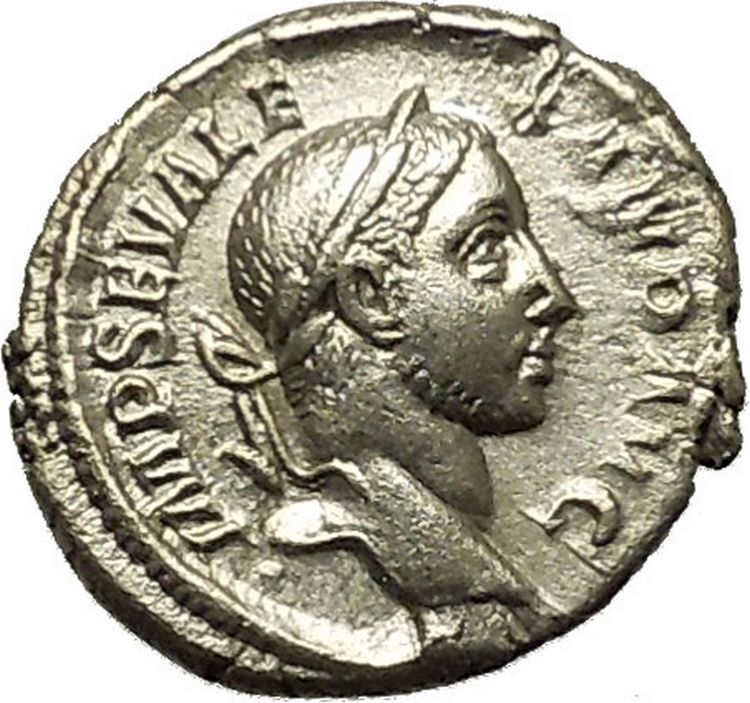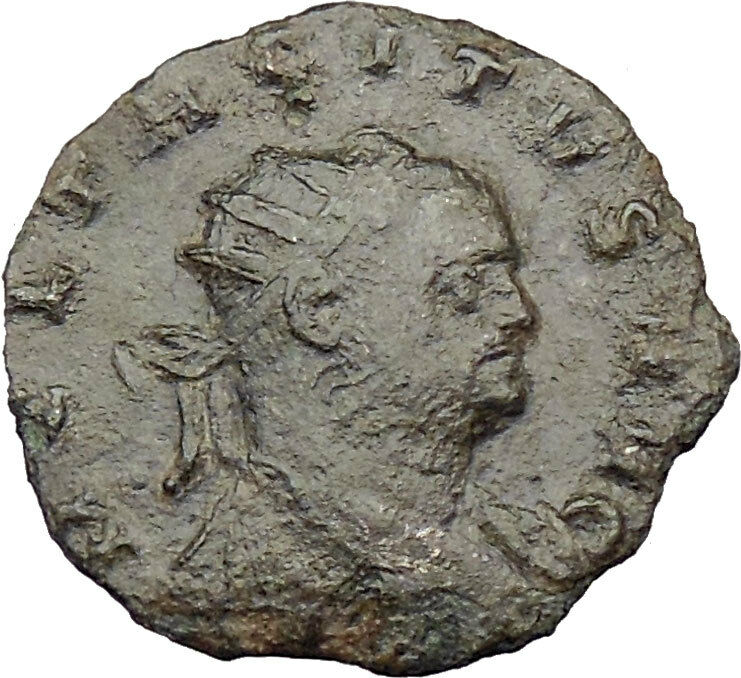Modern-era
|
|
Licinius I (Latin:
Gaius Valerius Licinianus Licinius Augustus[note
1 c. 263 – 325), was
Roman Emperor
from 308 to 324. For the majority
of his reign he was the colleague and rival of
Constantine I
, with whom he co-authored the
Edict of Milan
that granted official toleration
to Christians in the Roman Empire. He was finally defeated at the
Battle of Chrysopolis
, before being executed on
the orders of Constantine I.

Constantine I
(right).
Early reign

Born to a Dacian
[5][6]
peasant family in Moesia
Superior, Licinius accompanied his close
childhood friend, the future emperor
Galerius
, on the Persian expedition in 298.[5]
He was trusted enough by Galerius that in 307 he was sent as an envoy to
Maxentius
in
Italy
to attempt to reach some agreement about
his illegitimate status.[5]
Galerius then trusted the eastern provinces to Licinius when he went to deal
with Maxentius personally after the death of
Flavius Valerius Severus
.[7]
Upon his return to the east Galerius elevated Licinius to the rank of
Augustus in the West
on November 11, 308. He
received as his immediate command the provinces of
Illyricum
,
Thrace
and
Pannonia
.[6]
In 310 he took command of the war against the
Sarmatians
, inflicting a severe defeat on them
and emerging victorious.[3]
On the death of Galerius in May 311, Licinius entered into an agreement with
Maximinus II
(Daia) to share the eastern
provinces between them. By this point, not only was Licinius the official
Augustus of the west, but he also possessed part of the eastern provinces as
well, as the
Hellespont
and the
Bosporus
became the dividing line, with
Licinius taking the European provinces and Maximinus taking the Asian.[6]
An alliance between Maximinus and Maxentius forced the two remaining emperors
to enter into a formal agreement with each other.[7]
So in March 313 Licinius married
Flavia Julia Constantia
, half-sister of
Constantine I
,[4]
at Mediolanum (now Milan
); they had a son,
Licinius the Younger
, in 315. Their marriage
was the occasion for the jointly-issued “Edict
of Milan” that reissued Galerius’ previous edict allowing
Christianity
to be professed in the Empire,[6]
with additional dispositions that restored confiscated properties to Christian
congregations and exempted Christian clergy from municipal civic duties.[8]
The redaction of the edict as reproduced by
Lactantius
– who follows the text affixed by
Licinius in Nicomedia
on June 14 313, after Maximinus’
defeat – uses a neutral language, expressing a will to propitiate “any Divinity
whatsoever in the seat of the heavens”.

Coin of Licinius
Daia in the meantime decided to attack Licinius. Leaving Syria with 70,000
men, he reached Bithynia
, although harsh weather he encountered
along the way had gravely weakened his army. In April 313, he crossed the
Bosporus
and went to
Byzantium
, which was held by Licinius’ troops.
Undeterred, he took the town after an eleven-day siege. He moved to Heraclea,
which he captured after a short siege, before moving his forces to the first
posting station. With a much smaller body of men, possibly around 30,000,[10]
Licinius arrived at
Adrianople
while Daia was still besieging
Heraclea
. Before the decisive engagement,
Licinius allegedly had a vision in which an angel recited him a generic prayer
that could be adopted by all cults and which Licinius then repeated to his
soldiers.[11]
On 30 April 313, the two armies clashed at the
Battle of Tzirallum
, and in the ensuing battle
Daia’s forces were crushed. Ridding himself of the imperial purple and dressing
like a slave, Daia fled to
Nicomedia
.[7]
Believing he still had a chance to come out victorious, Daia attempted to stop
the advance of Licinius at the
Cilician Gates
by establishing fortifications
there. Unfortunately for Daia, Licinius’ army succeeded in breaking through,
forcing Daia to retreat to
Tarsus
where Licinius continued to press him on
land and sea. The war between them only ended with Daia’s death in August 313.[6]
Given that Constantine had already crushed his rival Maxentius in 312, the
two men decided to divide the Roman world between them. As a result of this
settlement, Licinius became sole Augustus in the East, while his brother-in-law,
Constantine, was supreme in the West. Licinius immediately rushed to the east to
deal with another threat, this time from the Persian
Sassanids
.[7]
Conflict with
Constantine I
In 314, a civil war erupted between Licinius and Constantine, in which
Constantine used the pretext that Licinius was harbouring Senecio, whom
Constantine accused of plotting to overthrow him.[7]
Constantine prevailed at the
Battle of Cibalae
in
Pannonia
(October 8, 314).[6]
Although the situation was temporarily settled, with both men sharing the
consulship
in 315, it was but a lull in the
storm. The next year a new war erupted, when Licinius named
Valerius Valens
co-emperor,[4]
only for Licinius to suffer a humiliating defeat on the plain of
Mardia
(also known as
Campus Ardiensis
) in
Thrace
. The emperors were reconciled after
these two battles and Licinius had his co-emperor Valens killed.[6]
Over the next ten years, the two imperial colleagues maintained an uneasy
truce.[7]
Licinius kept himself busy with a campaign against the Sarmatians in 318,[6]
but temperatures rose again in 321 when Constantine pursued some Sarmatians, who
had been ravaging some territory in his realm, across the Danube into what was
technically Licinius’s territory.[6]
When he repeated this with another invasion, this time by the
Goths
who were pillaging
Thrace
, Licinius complained that Constantine
had broken the treaty between them.
Constantine wasted no time going on the offensive. Licinius’s fleet of 350
ships was defeated by Constantine I’s fleet in 323. Then in 324, Constantine,
tempted by the “advanced age and unpopular vices”[7]
of his colleague, again declared war against him, and, having defeated his army
of 170,000 men[dubious
] at the
Battle of Adrianople
(July 3, 324), succeeded
in shutting him up within the walls of
Byzantium
.[6]
The defeat of the superior fleet of Licinius in the
Battle of the Hellespont
by
Crispus
, Constantine’s eldest son and
Caesar
, compelled his withdrawal to
Bithynia
, where a last stand was made; the
Battle of Chrysopolis
, near
Chalcedon
(September 18), resulted in Licinius’
final submission.[7]
While Licinius’ co-emperor
Sextus Martinianus
was killed, Licinius himself
was spared due to the pleas of his wife, Constantine’s sister, and interned at
Thessalonica
.[4]
The next year, Constantine had him hanged, accusing him of conspiring to raise
troops among the barbarians.[7]
Character and legacy
Constantine made every effort to blacken the reputation of his imperial
colleague. To this end, stories began circulating about Licinius’s cruelty. It
was said that he had put to death Severianus, the son of the emperor Severus, as
well as Candidianus, the son of Galerius.[7]
To this was added the execution of the wife and daughter of the Emperor
Diocletian
, who had fled from the court of
Licinius before being discovered at
Thessalonica
.[7]
Much of this can be considered imperial propaganda on the part of Constantine.
In addition, as part of Constantine’s attempts to decrease Licinius’s
popularity, he actively portrayed his brother-in-law as a pagan supporter. This
was not the case; contemporary evidence tends to suggest that he was at least a
committed supporter of Christians.[4]
He co-authored the Edict of Milan which ended the
Great Persecution
, and re-affirmed the rights
of Christians in his half of the empire. He also added the Christian symbol to
his armies, and attempted to regulate the affairs of the Church hierarchy just
as Constantine and his successors were to do. His wife was a devout Christian.[12]
It is even a possibility that he converted.[4]
However,
Eusebius of Caesarea
, writing under the rule of
Constantine, charges him with expelling Christians from the Palace and ordering
military sacrifice, as well as interfering with the Church’s internal procedures
and organization.[13]
According to Eusebius, this turned what appeared to be a committed Christian
into a man who feigned sympathy for the sect but who eventually exposed his true
bloodthirsty pagan nature, only to be stopped by the virtuous Constantine.[4]
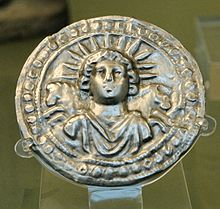
repoussé
silver
disc of Sol Invictus (3rd
century), found at
Pessinus
(British
Museum)
Sol Invictus (“Unconquered Sun”) was the official
sun god
of the later
Roman Empire
and a patron of soldiers. In 274
the Roman emperor
Aurelian
made it an official
cult alongside the traditional Roman cults. Scholars disagree whether
the new deity was a refoundation of the ancient
Latin
cult of
Sol
,
a revival of the cult of
Elagabalus
or completely new.The god was
favored by emperors after Aurelian and appeared on their coins until
Constantine
.The last inscription referring to
Sol Invictus dates to 387 AD and there were enough devotees in the 5th century
that
Augustine
found it necessary to preach against
them.
It is commonly claimed that the date of 25 December for
Christmas
was selected in order to correspond
with the Roman festival of Dies Natalis Solis Invicti, or “Birthday of
the Unconquered Sun”, but this view is challenged
Invictus as
epithet
Invictus
(“Unconquered, Invincible”) was an
epithet
for
several deities
of
classical Roman religion
, including the supreme
deity
Jupiter
, the war god
Mars
,
Hercules
,
Apollo
and
Silvanus
.[8]
Invictus was in use from the 3rd century BC, and was well-established as
a
cult
title when applied to
Mithras
from the 2nd century onwards. It has a
clear association[vague]
with solar deities and solar monism; as such, it became the preferred epithet of
Rome’s traditional
Sol
and the novel, short-lived Roman state cult
to
Elagabalus
, an
Emesan
solar deity who headed Rome’s official
pantheon under his
namesake emperor
.
The earliest dated use of Sol invictus is in a dedication from Rome,
AD 158. Another, stylistically dated to the 2nd century AD, is inscribed on a
Roman
phalera
: “inventori lucis soli invicto
augusto” (to the contriver of light, sol invictus augustus ). Here
“augustus” is most likely a further epithet of Sol as “august” (an elevated
being, divine or close to divinity), though the association of Sol with the
Imperial house would have been unmistakable and was already established in
iconography and stoic monism. These are the earliest attested examples of Sol as
invictus, but in AD 102 a certain
Anicetus
restored a shrine of Sol; Hijmans
(2009, 486, n. 22) is tempted “to link Anicetus’ predilection for Sol with his
name, the
Latinized
form of the Greek word ἀνίκητος,
which means invictus“.
Elagabalus
The first sun god consistently termed invictus was the
provincial Syrian
god
Elagabalus
. According to the
Historia Augusta
, the
teenaged Severan heir
adopted the name of his
deity and brought his cult image from Emesa to Rome. Once installed as emperor,
he neglected Rome’s traditional State deities and promoted his own as Rome’s
most powerful deity. This ended with his murder in 222.
The Historia Augusta refers to the deity Elagabalus as “also called
Jupiter and Sol” (fuit autem Heliogabali vel Iovis vel Solis).This has
been seen as an abortive attempt to impose the Syrian sun god on Rome;
but because it is now clear that the Roman cult of Sol remained
firmly established in Rome throughout the Roman period,this Syrian
Sol Elagabalus
has become no more relevant to
our understanding of the Roman
Sol
than, for example, the Syrian
Jupiter Dolichenus
is for our understanding of
the Roman Jupiter.
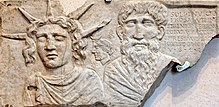
Sol Invictus
Aurelian
The Roman gens
Aurelian was associated with the cult
of Sol. After his victories in the East, the Emperor
Aurelian
thoroughly reformed the Roman cult of
Sol, elevating the sun-god to one of the premier divinities of the Empire. Where
previously priests of Sol had been simply
sacerdotes
and tended to belong to lower
ranks of Roman society, they were now pontifices and members of the new
college of pontifices
instituted by Aurelian.
Every pontifex of Sol was a member of the senatorial elite, indicating that the
priesthood of Sol was now highly prestigious. Almost all these senators held
other priesthoods as well, however, and some of these other priesthoods take
precedence in the inscriptions in which they are listed, suggesting that they
were considered more prestigious than the priesthood of Sol.Aurelian also built
a new temple for Sol, bringing the total number of temples for the god in Rome
to (at least) four[21]
He also instituted games in honor of the sun god, held every four years from AD
274 onwards.
The identity of Aurelian’s Sol Invictus has long been a subject of scholarly
debate. Based on the
Historia Augusta
, some scholars have argued
that it was based on
Sol Elagablus
(or Elagabla) of
Emesa
. Others, basing their argument on
Zosimus
, suggest that it was based on the
Helios
, the solar god of
Palmyra
on the grounds that Aurelian placed and
consecrated a cult statue of Helios looted from Palmyra in the temple of Sol
Invictus. Professor Gary Forsythe discusses these arguments and add a third more
recent one based on the work of Steven Hijmans. Hijmans argues that Aurelian’s
solar deity was simply the traditional Greco-Roman Sol Invictus.
Constantine
Emperors portrayed Sol Invictus on their official coinage, with a wide range
of legends, only a few of which incorporated the epithet invictus, such
as the legend SOLI INVICTO COMITI, claiming the Unconquered Sun
as a companion to the Emperor, used with particular frequency by Constantine.
Statuettes of Sol Invictus, carried by the standard-bearers,
appear in three places in reliefs on the
Arch of Constantine
. Constantine’s official
coinage continues to bear images of Sol until 325/6. A
solidus
of Constantine as well as a gold
medallion from his reign depict the Emperor’s bust in profile twinned (“jugate”)
with Sol Invictus, with the legend INVICTUS CONSTANTINUS
Constantine decreed (March 7, 321) dies Solis—day of the sun, “Sunday“—as
the Roman day of rest [CJ3.12.2]:
- On the venerable day of the Sun let the magistrates and people residing
in cities rest, and let all workshops be closed. In the country however
persons engaged in agriculture may freely and lawfully continue their
pursuits because it often happens that another day is not suitable for
grain-sowing or vine planting; lest by neglecting the proper moment for such
operations the bounty of heaven should be lost.
Constantine’s triumphal arch was carefully positioned to align with the
colossal statue of Sol
by the
Colosseum
, so that Sol formed the dominant
backdrop when seen from the direction of the main approach towards the arch.[26]
Sol and the
other Roman Emperors
Berrens
deals with coin-evidence of Imperial connection to the Solar
cult. Sol is depicted sporadically on imperial coins in the 1st and 2nd
centuries AD, then more frequently from
Septimius Severus
onwards until AD 325/6.
Sol invictus appears on coin legends from AD 261, well before the reign of
Aurelian.
Connections between the imperial radiate crown and the cult of
Sol are postulated.
Augustus
was posthumously depicted with radiate
crown, as were living emperors from
Nero (after AD 65) to
Constantine
. Some modern scholarship interprets
the imperial radiate crown as a divine, solar association rather than an overt
symbol of Sol; Bergmann calls it a pseudo-object designed to disguise the divine
and solar connotations that would otherwise be politically controversial
but there is broad agreement that coin-images showing the
imperial radiate crown are stylistically distinct from those of the solar crown
of rays; the imperial radiate crown is depicted as a real object rather than as
symbolic light. Hijmans argues that the Imperial radiate crown represents the
honorary wreath awarded to
Augustus
, perhaps posthumously, to commemorate
his victory at the
battle of Actium
; he points out that
henceforth, living emperors were depicted with radiate crowns, but state divi
were not. To Hijmans this implies the radiate crown of living emperors as a link
to Augustus. His successors automatically inherited (or sometimes acquired) the
same offices and honours due to Octavian as “saviour of the Republic” through
his victory at Actium, piously attributed to Apollo-Helios. Wreaths awarded to
victors at the Actian Games were radiate.
Sol
Invictus and Christianity and Judaism

Sol
or
Apollo-Helios
in Mausoleum M in the
pre-4th-century necropolis beneath[33]
St. Peter’s in the Vatican
, which
many interpret as representing Christ
The
Philocalian calendar
of AD 354 gives a festival
of “Natalis Invicti” on 25 December. There is limited evidence that this
festival was celebrated before the mid-4th century.
The idea that Christians chose to celebrate the birth of Jesus on 25 December
because this was the date of an already existing festival of the Sol Invictus
was expressed in an annotation to a manuscript of a work by 12th-century Syrian
bishop
Jacob Bar-Salibi
. The scribe who added it
wrote: “It was a custom of the Pagans to celebrate on the same 25 December the
birthday of the Sun, at which they kindled lights in token of festivity. In
these solemnities and revelries the Christians also took part. Accordingly when
the doctors of the Church perceived that the Christians had a leaning to this
festival, they took counsel and resolved that the true Nativity should be
solemnised on that day.”
This idea became popular especially in the 18th and 19th centuries
and is still widely accepted.
In the judgement of the Church of England Liturgical Commission, this view
has been seriously challenged
by a view based on an old tradition, according to which the
date of Christmas was fixed at nine months after 25 March, the date of the
vernal equinox, on which the
Annunciation
was celebrated.
The Jewish calendar date of 14 Nisan was believed to be that
of the beginning of creation, as well as of the Exodus and so of Passover, and
Christians held that the new creation, both the death of Jesus and the beginning
of his human life, occurred on the same date, which some put at 25 March in the
Julian calendar.[40][42][43]
It was a traditional Jewish belief that great men lived a whole number of years,
without fractions, so that Jesus was considered to have been conceived on 25
March, as he died on 25 March, which was calculated to have coincided with 14
Nisan.[44]
Sextus Julius Africanus
(c.160 – c.240) gave 25
March as the day of creation and of the conception of Jesus.
The tractate De solstitia et aequinoctia conceptionis et
nativitatis Domini nostri Iesu Christi et Iohannis Baptistae falsely
attributed to
John Chrysostom
also argued that Jesus was
conceived and crucified on the same day of the year and calculated this as 25
March.
A passage of the Commentary on the prophet Daniel by
Hippolytus of Rome
, written in about 204, has
also been appealed to.
Among those who have put forward this view are Louis Duchesne,Thomas J.
Talley, David J. Rothenberg, J. Neil Alexander, and Hugh Wybrew.
Not all scholars who view the celebration of the birth of Jesus on 25
December as motivated by the choice of the winter solstice rather than
calculated on the basis of the belief that he was conceived and died on 25 March
agree that it constituted a deliberate Christianization of a festival of the
Birthday of the Unconquered Sun. Michael Alan Anderson writes:
Both the sun and Christ were said to be born anew on December 25. But
while the solar associations with the birth of Christ created powerful
metaphors, the surviving evidence does not support such a direct association
with the Roman solar festivals. The earliest documentary evidence for the
feast of Christmas makes no mention of the coincidence with the winter
solstice. Thomas Talley has shown that, although the Emperor Aurelian’s
dedication of a temple to the sun god in the Campus Martius (C.E. 274)
probably took place on the ‘Birthday of the Invincible Sun’ on December 25,
the cult of the sun in pagan Rome ironically did not celebrate the winter
solstice nor any of the other quarter-tense days, as one might expect. The
origins of Christmas, then, may not be expressly rooted in the Roman
festival.
The same point is made by Hijmans: “It is cosmic symbolism…which inspired
the Church leadership in Rome to elect the southern solstice, December 25, as
the birthday of Christ … While they were aware that pagans called this day the
‘birthday’ of Sol Invictus, this did not concern them and it did not play any
role in their choice of date for Christmas.” He also states that, “while the
winter solstice on or around December 25 was well established in the Roman
imperial calendar, there is no evidence that a religious celebration of Sol on
that day antedated the celebration of Christmas”.
The Oxford Companion to Christian Thought also remarks on the
uncertainty about the order of precedence between the celebrations of the
Birthday of the Unconquered Sun and the birthday of Jesus: “This ‘calculations’
hypothesis potentially establishes 25 December as a Christian festival before
Aurelian’s decree, which, when promulgated, might have provided for the
Christian feast both opportunity and challenge.”
Susan K. Roll also calls “most extreme” the unproven hypothesis that “would
call Christmas point-blank a ‘christianization’ of Natalis Solis Invicti, a
direct conscious appropriation of the pre-Christian feast, arbitrarily placed on
the same calendar date, assimilating and adapting some of its cosmic symbolism
and abruptly usurping any lingering habitual loyalty that newly-converted
Christians might feel to the feasts of the state gods”.
The comparison of Christ with the astronomical
Sun
is common in ancient Christian writings.
In the 5th century,
Pope Leo I
(the Great) spoke in several sermons
on the Feast of the Nativity of how the celebration of Christ’s birth coincided
with increase of the sun’s position in the sky. An example is: “But this
Nativity which is to be adored in heaven and on earth is suggested to us by no
day more than this when, with the early light still shedding its rays on nature,
there is borne in upon our senses the brightness of this wondrous mystery.
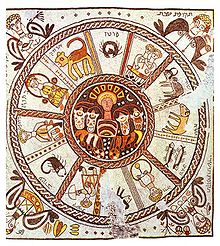
Beth Alpha
synagogue, with the sun
in the centre, surrounded by the twelve zodiac constellations and
with the four seasons associated inaccurately with the
constellations
A study of
Augustine of Hippo
remarks that his exhortation
in a Christmas sermon, “Let us celebrate this day as a feast not for the sake of
this sun, which is beheld by believers as much as by ourselves, but for the sake
of him who created the sun”, shows that he was aware of the coincidence of the
celebration of Christmas and the Birthday of the Unconquered Sun, although this
pagan festival was celebrated at only a few places and was originally a
peculiarity of the Roman city calendar. It adds: “He also believes, however,
that there is a reliable tradition which gives 25 December as the actual date of
the birth of our Lord.”
By “the sun of righteousness” in
Malachi 4:2
“the
fathers
, from
Justin
downward, and nearly all the earlier
commentators understand Christ, who is supposed to be described as the
rising sun”.
The
New Testament
itself contains a hymn fragment:
“Awake, O sleeper, and arise from the dead, and Christ will shine on you.”
Clement of Alexandria
wrote of “the Sun of the
Resurrection, he who was born before the dawn, whose beams give light”.
Christians adopted the image of the Sun (Helios
or Sol Invictus) to represent Christ. In this portrayal he is a beardless figure
with a flowing cloak in a chariot drawn by four white horses, as in the mosaic
in Mausoleum M discovered under
Saint Peter’s Basilica
and in an
early-4th-century catacomb fresco.
Clement of Alexandria had spoken of Christ driving his chariot
in this way across the sky. The nimbus of the figure under Saint Peter’s
Basilica is described by some as rayed,
as in traditional pre-Christian representations, but another
has said: “Only the cross-shaped nimbus makes the Christian significance
apparent” (emphasis added). Yet another has interpreted the figure as a
representation of the sun with no explicit religious reference whatever, pagan
or Christian.
The traditional image of the sun is used also in Jewish art. A mosaic floor
in Hamat Tiberias
presents
David
as Helios surrounded by a ring with the
signs of the zodiac
.As well as in Hamat Tiberias, figures of
Helios or Sol Invictus also appear in several of the very few surviving schemes
of decoration surviving from Late Antique
synagogues
, including
Beth Alpha
,
Husefah
(Husefa) and
Naaran
, all now in
Israel
. He is shown in floor mosaics, with the
usual radiate halo, and sometimes in a
quadriga
, in the central roundel of a circular
representation of the zodiac or the seasons. These combinations “may have
represented to an agricultural Jewish community the perpetuation of the annual
cycle of the universe or … the central part of a calendar”.
Finally, on Licinius’s death, his memory was branded with infamy; his statues
were thrown down; and by edict, all his laws and judicial proceedings during his
reign were abolished
|
|
|
Frequently Asked d Questions How long until my order is shipped?: shipment of your order after the receipt of payment. How will I know when the order was shipped?: date should be used as a basis of estimating an arrival date. After you shipped the order, how long will the mail take? international shipping times cannot be estimated as they vary from country to country. I am not responsible for any USPS delivery delays, especially for an international package. What is a certificate of authenticity and what guarantees do you give that the item is authentic? and a Lifetime Guarantee of Authenticity, issued by a world-renowned numismatic and antique expert that has identified over 10000 ancient coins and has provided them with the same guarantee. You will be quite happy with what you get with the COA; a professional presentation of the coin, with all of the relevant information and a picture of the coin you saw in the listing. Compared to other certification companies, the certificate of authenticity is a $25-50 value. So buy a coin today and own a piece of history, guaranteed. Is there a money back guarantee? I offer a 30 day unconditional money back guarantee. I stand behind my coins and would be willing to exchange your order for either store credit towards other coins, or refund, minus shipping expenses, within 30 days from the receipt of your order. My goal is to have the returning customers for a lifetime, and I am so sure in my coins, their authenticity, numismatic value and beauty, I can offer such a guarantee. Is there a number I can call you with questions about my order?
You can contact me directly via ask seller a question and request my telephone number, or go to my About Me Page to get my contact information only in regards to items purchased on eBay. When should I leave feedback? order, please leave a positive. Please don’t leave any negative feedbacks, as it happens many times that people rush to leave feedback before letting sufficient time for the order to arrive. Also, if you sent an email, make sure to check for my reply in your messages before claiming that you didn’t receive a response. The matter of fact is that any issues can be resolved, as reputation is most important to me. My goal is to provide superior products and quality of service. |






